Madeleine et Madeleine: Couture Innovation for the Parisian Woman at Sea and in Society
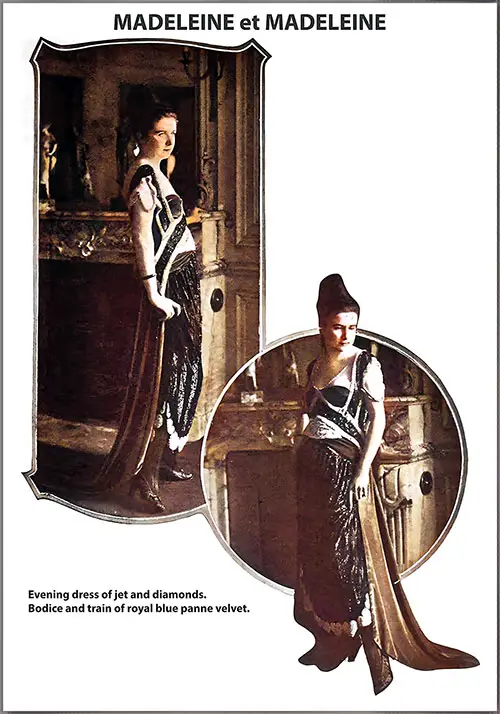
Evening Dress of Jet and Diamonds. Bodice and Train of Royal Blue Panne Velvet. Garment Manufacturers' Index, September 1920. GGA Image ID # 1a4df53a39
🌟 “Madeleine et Madeleine - Parisian Elegance from Drawing Room to Deck” 🌟
The article on Madeleine et Madeleine, a Parisian fashion house founded in 1919, is an extraordinary resource that showcases the dynamic fusion of tradition and innovation in early 20th-century couture. Designed with remarkable artistry and elegance, the garments and accessories offer valuable insight into both fashion history and the lifestyle of upper-class women during the interwar period — particularly those engaged in ocean travel.
Madeleine et Madeleine, established in 1919, have found it necessary to enlarge their premises under growing success. The first Madeleine used to be with Drecoll, and the second Madeleine with Jeanne Hallée.
This young and promising house is financed by a group of old French nobility, including the Comte de Munand Comte Hubert de Montégut.
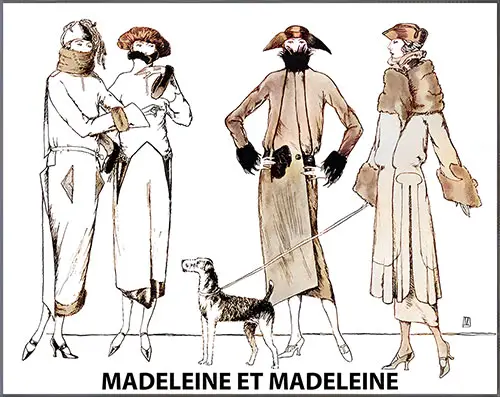
Outerwear Fashions Designed by Medeleine et Madeleine. Harper's Bazar, August 1921, p. 31. GGA Image ID # 1cc77b1651
One of the most intriguing collections showcased in Paris this fall is that of Madeleine et Madeleine. Their straight lines, introduced during the Pannier period, have made a significant impact. It's worth noting that they pioneered the low-waisted effect, a truly innovative concept.
As the torch passes from one season to another, we are thrilled to find a wide array of tailor-made products that have improved upon the spring styles this autumn.
The variety of materials used in the designs is truly impressive: from mixy tweeds in greys, serge, velours de laine, and duvetyn, which seem to be the foundation everywhere, to brocade and moiré for the afternoon tailleurs and many plain velvets stamped in checks or, in one case, black with a pinstripe of white.

Ingratiatingly Demure Is a One-Piece Dress of Black Taffeta With White Mousseline Sleeves, Made for Southern Days by Madeleine et Madeleine. The Eternal Fitness of Black and White Is Shown When Madeleine and Madeleine Bead a Tunic of White Shantung in Black, Adding a Slip of Black. Harper's Bazar, February 1921, p. 31. GGA Image ID # 1cc7a1b4a4
The range of colors includes many reds, blues, négre, bottle green, shades of brown, and black.
All the skirts are plain, no matter what type the jacket belongs to; the coats, be they severe or fancy, with few exceptions, favor the long basques, flaring very little, the flat back and front, and the length varying from knee to hem.
In tweeds and rough stuff, we find masculine revers and tailored sleeves, the suit worn with a separate fur. Otherwise, most have high fur collars, turned over or erect and fan-shaped.
An interesting example of the tweed style is a grey and black plaid coat worn with a blue serge skirt. In contrast, a handsome afternoon suit of black velvet, the jacket a few inches shorter than the skirt, has a high Kolinsky collar, the extensive sleeves edged with the same; the flaring side panels are embroidered in flat silk roses of narrow silk braid.
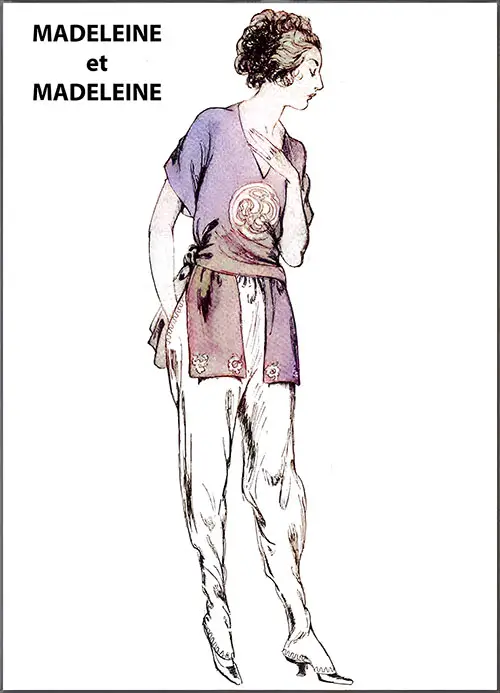
Wearing Them Is Perfectly Possible When They Are of Buff-Colored Taffeta and Worn With an Over-Blouse of Blue Satin To Compose a Fetching Boudoir Costume by Medeleine et Madeleine. Harper's Bazar, February 1921, p. 46. GGA Image ID # 1cc7aa5a6d
Another dress is a tight chemise of white Georgette with a velvet hem; the whole frock is worked in the same black braided flowers. Occasionally, the back of the jacket is longer than the front, but in the case of another black velvet with a white fox collar, the side gores dip down in points to the hem.
The trimmings are always original and interesting. One of the few examples of short coats is a blue serge, with a small seal collar belted and fastened to one side. The suit's importance relies on the sleeves, which are immense and bell-shaped. The shoulder and outer part are trimmed in horizontal strips of scarlet leather framed in gold embroidery. Another medium-length blue tailor is adorned with a coat and skirt in turquoise blue-fuzzy woolen braid squares.
We have elaborate coats matching the frock underneath by the side of three misses suits. Capes are equally numerous, while a few short fur coats are essayed, proving a marked contrast.
A short, old-fashioned jacket, hip-length, of baby seal accompanies a blue duvetyn, while a delightful little white lamb coat (with a high fan-shaped collar) forming a cape at the back, to the waist, is lined with mauve panne and goes with a dress of the same material.

Recent Importations Reveal the Fact That the French Couturiers Are Favoring the Side Skirt Drapery First Introduced by Callot and Madeleine et Madeleine. The American Cloak and Suit Review, March 1920, p. 168. GGA Image ID # 1cc8ba9c34
There are numerous fur wraps; Madeleine et Madeleine launched baby lamb this year, dyed in fawns and greys or, better still, left white. A coffee lamb coat, very plain and comfortable with a high rolling collar, the same model as the white melton and white lamb, was much noticed.
Here are two tight, round capes, the first of priceless broad tail, the second of seal scalloped around the hem, the intervals between the scallops filled in by finely pleated black silk muslin; both are very chic.
The capes here are built on one model, varied by materials and trimmings. They are very tight and sleeveless, minus arm slits, even, with relatively small fur collars. The simplest is merely blue serge; the chic lies in the narrow seal collar tied in the back by blue serge streamers.
A wine-colored tweed is clever with its immense detached panel swinging clear from the neck at the back. When trimmed capes are in panels or pleating, let in at the sides.
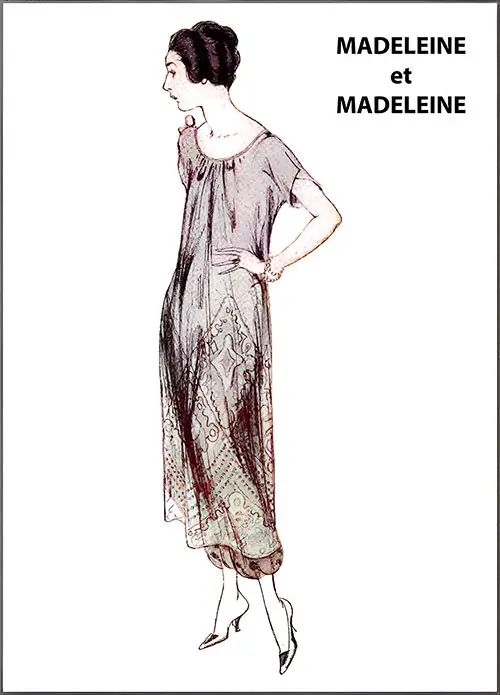
A Tunic of Jade Green Crêpe and Gold Embroidered Chiffon With Turkish Trousers of the Chiffon Shown Beneath by Madeleine et Madeleine Will Gratify Any Woman's Desire for Color. Harper's Bazar, February 1921, p. 46. GGA Image ID # 1cc7b66492
Speaking of pleats reminds me that one blue duvetyn has a detached accordion lining of voile finished off at the hem in deep red, which is very chic and unusual.
An original négre panne cape has as its only ornament a small round collar of shiny lophophore feathers worn with a dress of négre lace over satin trimmed sparsely with the same feathers.
Evening capes are embroidered heavily on the narrow yokes and huge sleeves; one made of black velvet is heavily traced in gold.
To return to coats after this long digression, the line is long and rather skimpy or with a slight flare at the sides. A high collar buries the chin, and the sleeves are wide.
One old blue velours de laine has no sleeves, barring long slits, which does not matter as the dress underneath has long ones of the same material. The coat with a sable collar is exceptionally tight to the knees, where a band is shirred on a little, the stuff slashed into tiny strips, revealing a gleam of gold lace underneath.
A Havana ratine has an original skunk collar that is edged with the animal's tails. Black plush is distinctive, but I have kept a beautiful coat of Royal blue velvet to the last.
It has a low beltline from which the skirt is shirred on very full, a huge Kolinsky collar and cuffs, and fastens at the waist under a cut jet ornament. A dress of the same color goes with it.
Stamped velvets, charmeuse, satin cloth, panne, moiré, duvetyn, and serge are used pèle-mèle for afternoon wear. After black, white, and blue, the Parisian stand-bys, we find Royal blue, turquoise, fawns, Havanas, chocolate, nasturtium, and brick widely liked.
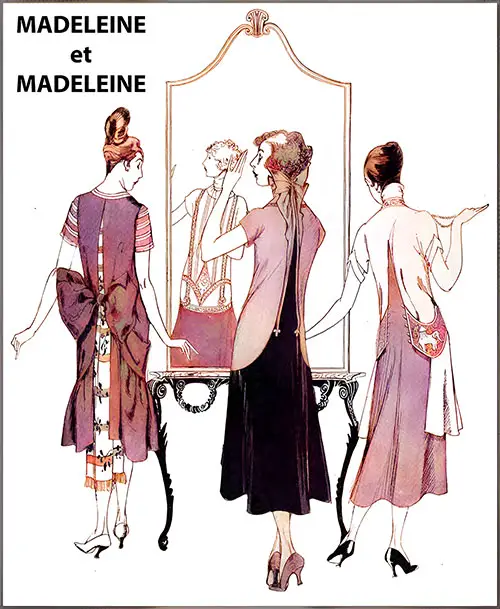
The Paris Openings Declare the Supremacy of the Straight Silhouette. These Fashionable Outfits by Madeleine et Madeleine. Harper's Bazar, April 1921, p. 39. GGA Image ID # 1cc7bb8909
The house's characteristic line is flat and long-waisted, with the skirt caught up to one side very slightly to accentuate the narrow, unbroken line to the feet. With this silhouette, high collars predominate, although they are not absolutely the rule, as the straight-across-the-shoulder and rounded neck also exist.
The newest high collar closely follows the throat line and tightly encases the chin; flowing sleeves (or the width at the wrist gathered into a narrow cuff) are the most popular.
Monkeys, black or white, make several collars, and so do baby seals; a white silk muslin tunic edged by a black monkey over dark satin is one of the few ways it is used here.

A Girdle of Silver Tissue Double Crosses an Evening Gown Made of Mauve and Silver Brocade and Worn With a Coat of Mauve Velvet. The Cascade Draperies Fall Naturally Into the Uneven Hem, Awl the Coat Is Made With a Long Wide Sleeve From Madeleine et Madeleine. The Delineator, January 1922, p. 25. GGA Image ID # 1cc8c0ad50
Embroidered panels and motifs are varied and plentiful; a favorite trimming is applications of the dress material cut into designs and applied on tulle or gold lace. On a brick-red and black satin gown is an embroidery of long black and brick fringe that is darned across and consolidated.
Large motifs of silk braid embroidered on the net prove very effective and are often used at one or both sides of the skirt over a drapery; thus, broad bands of flat red China pastilles catch a slightly draped blue serge at each side.
One amusing instance of unique resources is a side panel worked in steel letter clips and square blue beads. Another ingenious idea is using small tin buttons to outline a motif.
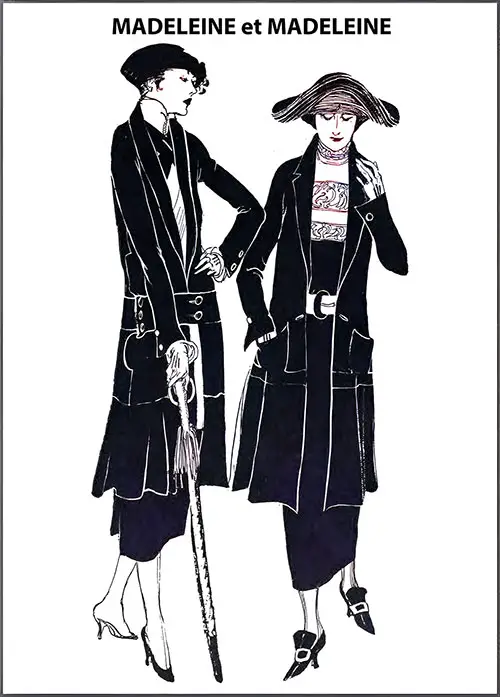
A Jade Blouse Gives Unusual Color to a Madeleine and Madeleine Tailleur of Black Serge Smartly Belted. The Skirt Flounce Is Again Noted. For a Three-piece Costume of Blue Serge, Madeleine and Madeleine Make a Blouse of Scarlet Crêpe and Add a Silver Belt Buckle With Red. Harper's Bazar, May 1921, p. 48. GGA Image ID # 1cc7cce5e0
A rather wild effect is given on a black satin with flowing muslin sleeves red by strings of red and black wooden beads swinging from the waist to the hem. The list is endless, with large mother-of-pearl motifs and plush, wool, and silk embroidery; we even have hand-painted roses on a ruffled black taffeta.
We find several combinations of lace over velvet; a deep, round, black lace yoke forms the top of a square velvet bodice, and long lace sleeves give a good line.
A model of black satin is edged around the hem by a broad band of stiff gold lace draped with the satin tightly to one side, the lace standing out like a fin! When the side of the drapery is left hanging free, it is often lined with a contrasting color; one severe black satin cloth reveals a lining of pale pink velvet.
The coat dress, beltless, with a few invisible gores at the waist, gives us even straighter lines; the simplest model I have ever seen is a blue serge ending at the neck in a scarf lined with red, wound around several times.
Another dress, two panels of coffee lamb back and front is duvetyn and plush embroidery at the sides.

Afternoon Gowns by Madeleine et Madeleine. Harper's Bazar, May 1921, p. 71. GGA Image ID # 1cc8032794
For the evening, we find very soft filmy effects; one cannot say there is any clearly defined line; panels, aprons, and lace capes give an indefinite line. However, two white velvet dinner dresses, both giving the narrow medieval line already described, enjoyed great success.
The first, with a round neck, has one black tulle and velvet shoulder knot, while the opposite side of the skirt, which is draped, has streamers of the same tulle, the ends trailing on the ground.
The second, also with a round neck and low waistline, has a deep yoke worked in black beads, a long hanging apron of black lace shirred at the back, and wide lace sleeves, this time embroidered in white beads.
The neckline for dinner dresses is relatively high, round, or straight across; my favorite materials are Georgette or chiffon.
A beautiful white Georgette with a sleeveless, straight, flat bodice is trimmed by bands of sapphires crossing the front and forming a low belt. The skirt is a succession of rounded detached panels edged with the sapphires.
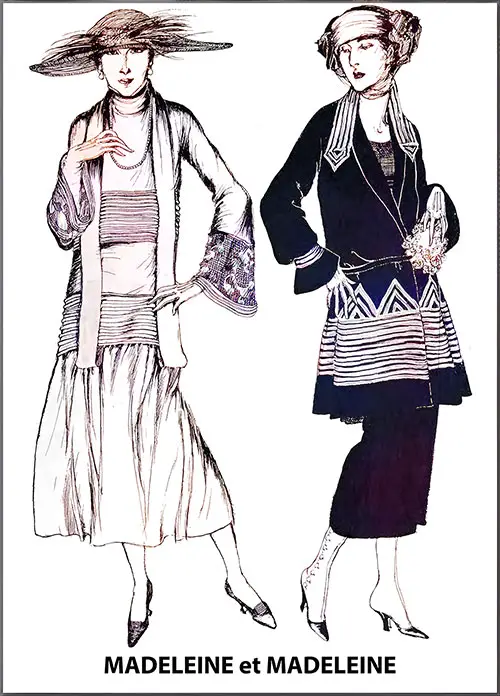
Street Gowns by Madeleine et Madeleine. (Harper's Bazar, July 1921) | GGA Image ID # 226e8eb365
We have very little metal brocade for a full dress, but many tulle gowns and muslin draperies; tight sheaths are accompanied by immense transparent coats caught at the waist or allowed to flow.
A biscuit brocade is covered by a ring of beige chiffon faintly embroidered in delicate colors and reaching the feet. A rose pink satin has a long blue muslin cape, weighted down, here and there, by large, flat, pink velvet flowers and forming a long train.
We find many pointed backs, round in front, tiny cap sleeves, and small side trains. Tulle dresses are short and fluffy. An arsenic one has huge butterfly bows as shoulder knots; a pale pink one has a belt (and trimmings here and there) of cream ostrich; and a pleated turquoise net, very much off the shoulders, is decorated with garlands of flowers.
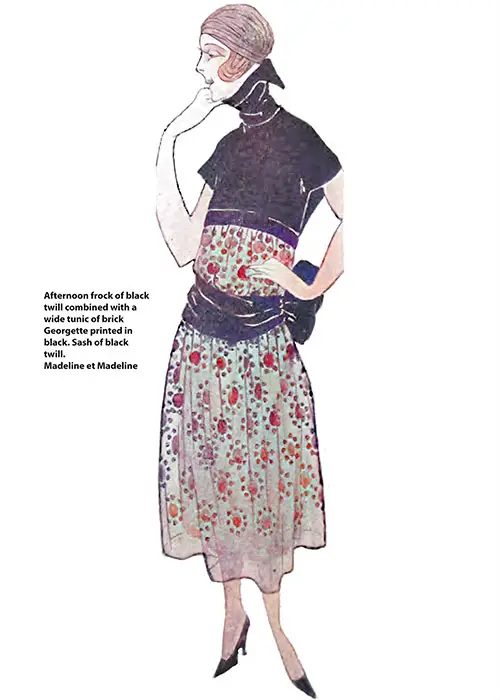
Afternoon Frock of Black Twill Combined With a Wide Tunic of Brick Georgette Printed in Black; Sash of Black Twill – By Madeleine ET Madeleine. (Garment Manufacturers' Index, April 1921) | GGA Image ID # 1a3c547c52
We consider Madeleine et Madeleine to have considerably contributed to realizing the slim, graceful silhouette of the present-day woman.
This year, while adhering to their well-known line, the collection has, if possible, improved on it through exquisite details and additional touches, which are only achieved when the style reaches the highest point of perfection.
The ever-low waistline is placed well over the hips, and the slight flare of the season begins there. This movement is exciting in the severe tailleurs, for the jacket, as a rule, three-quarter length has a slightly gored basque from the hips down.
Madeleine et Madeleine is the only house that has successfully attempted this difficult feat.
The collection of capes and wraps is large and complete; here, we find a most unusual double cape style, coming up high and collarless around the face. The top cape is the same length but often of a contrasting color to the under one.
This line gives many variations in the shape of double ruffles pleated or shirred and caught up, of detached panels revealing the first cape; a striking effect is that of bright blue panels over a red lining.
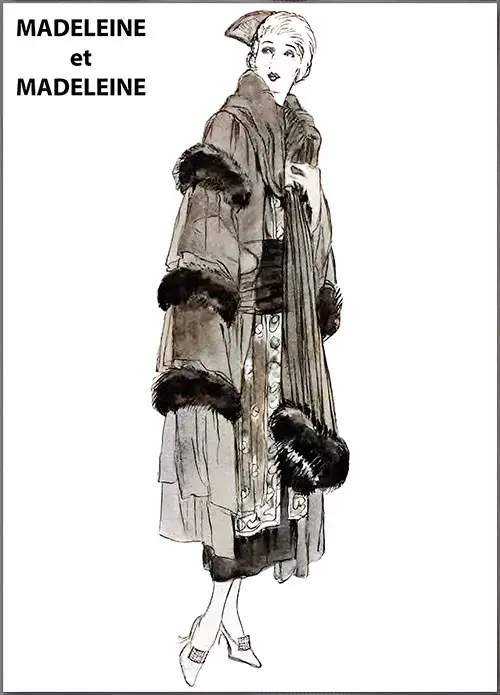
Outerwear Fashions by Madeleine et Madeleine, Crêpe of Dark Brown Chiffon. (Harper's Bazar, July 1921) | GGA Image ID # 1cc8ac9df9
Coat dresses show this house's line to perfection; a characteristic model is blue reps, a bell-shaped sheath, the low waist indicated by small inner gores; the collar has two large long scarves of blue lined with red, which tie in a thousand new ways.
Evening dresses are swathed in little lateral folds around the wearer in one long, unbroken line. I noticed many black satin for dinner gowns, the top part and back of black silk lace or spangle embroidered net floating or very tight long sleeves of these transparent materials. Clouds of black chiffon unexpectedly cover a wonderful gold brocade.
New Parisian "Reading Gowns"
Supple Kid Negligees Fur Trimmed—Mousseline de Soie and Crepe de Chine Dressing Gowns—Moyen Age Style Prevails—Fabric Designers Use Less Tinsel
By Doris Hemming.

A Madeleine Et Madeleine Blouse Model of Crêpe de Chine With Broderie Anglaise as a Trimming. (Women's Wear, February 1921) | GGA image ID # 226f0b2d7e
Paris.—The exclusive lingerie exhibit, Chez Madeleine et Madeleine, has been a rare and delightful mid-season event, adding a touch of luxury to the anticipation of next February’s openings. Under the umbrella of lingerie, the exhibit showcased not just undergarments and accessories but also a myriad of creations for the boudoir, a realm of Parisian indulgence.
The exhibition even featured table linen, home bibelots, Chinese and Japanese trinkets, tapestries, and unique pieces of furniture, all set against a backdrop of antique paintings.
Fine linen, or linon de fil, as the French express it, is the chosen material for the most exquisite Parisian lingerie. Chez Madeleine et Madeleine worked richly with hand embroidery and drawn thread effects, and it was trimmed with real lace, principally Valenciennes.
The embroidered designs comprised leaf motifs, birds, butterflies, and a few straightforward festoon patterns combined with rows of dots. The new lingerie is significantly cut, usually in straight lines. Nightgowns are often sleeveless, and combinations and chemises du jour are typically finished with a ribbon strap over the shoulders.
If anything, the lingerie fantasies of crepe de chine or triple voile were less attractive than the linon. Rose in color, it was trimmed with plain net, embroidered net, hemstitched, or light hand embroidery.
As for the house linen, color combinations were the dominant note, apart from a few very rich table sets that worked entirely in white. These sets introduced a touch of color in the embroidery on white ground. Flowers or persons were embroidered in delicate tones or made of brilliant linen appliqued. Another idea that deserves special mention is the odd center-piece or sideboard scarf heavily embroidered in Madeira style, the stitches being entirely silver.
Short Negligees
As a rule, the negligees and dressing sacques were short and instead made. The most interesting of these "reading gowns" were made of kid, very supple and dull in color, trimmed with printed patterns or designs of the same kid appliqued. Some of these fascination jackets were trimmed with white fur. In contrast, others of brilliant lamé were lined with colored marabout to match, the feathery lining being carried beyond the edge to make a fluffy border.
Rose Color for Dressing Gowns
Mousseline de Soie and crêpe de chine were chiefly used for the dressing gowns, which were fashioned on the simplest possible lines, creating a sense of comfort and ease.
For cold weather, quilted materials such as zenana were chosen and trimmed with a large collar, frogs, and a satin girdle of the same tone as the gown. In every case, the rose is my favorite color.
No collection of boudoir wraps nowadays is complete without the popular Japanese kimono. Madeleine et Madeleine showed several dark-colored satins lined with brilliant hues to match the embroidery, which was still further brightened with intricate touches of gold, adding a luxurious and opulent feel to the wraps.
Another detail that deserves comment was the trimming of long, elegant ostrich fringe on the elaborate robes made of crepe satin and other soft silks, which captured the audience's attention with their beauty.
Of Moyen Age Design
The tea gowns are entirely inspired by Moyen Age design, a theme that Madeleine et Madeleine have consistently embraced throughout their entire collection this season.
Brooches, lamés, and rich velvet are the favorite materials for these elegant gowns. Bands of mousseline are positioned along the sides, wide enough to fold over at the front like a double-breasted coat. In other designs, these flowing wings of sheer silk cascade down the sides, extending from the short sleeves.
The designer relies on contrasting elements for striking effects; for example, when a gown is made of rich gold or silver brocade, the floating wings are crafted from plain silk muslin. Conversely, when the gown is constructed from plain velvet, the mousseline is richly embroidered in silk or metallic threads.
Bibliography
"Madeleine et Madeleine" in the Garment Manufacturers' Index, New York: The Allen-Nugent Co. Publishers, Vol. II, No. 2, September 1920: 18-19.
"Madeleine et Madeleine," in Garment Manufacturers' Index, New York: The Allen-Nugent Co. Publishers, Vol. II, No. 9, April 1921. p. 18.
Doris Hemming "New Parisian Reading Gowns” in Women’s Wear, Toronto: H. Gagnier, Ltd., Vol. V, No. 2, February 1921, p. 16.
✨ Summary of Key Points for Educators, Historians, Genealogists & Fashion Scholars:
👗 Fashion as Social Identity
Madeleine et Madeleine’s creations — from streamlined tailleurs and elegant street dresses to elaborately detailed evening gowns — reflect how women of the time navigated modern life with poise and polish. These clothes weren’t just stylish; they were symbols of cultural refinement, often worn on ocean liners, in salons, or at Riviera resorts.
🚢 Ocean Travel Relevance
Many of the ensembles were clearly designed with the grand voyageuse in mind. From wool serge suits with detachable collars for brisk Atlantic crossings to silk evening capes perfect for shipboard soirées, these garments exemplified a new era of luxurious travel fashion.
The prominence of three-piece suits, cape styles, and light chiffon tunics points to practicality blended with opulence, ideal for transitioning from deck to dinner aboard luxury liners like the SS Paris or RMS Mauretania.
📚 Educational Value
This article is a goldmine for:
🔹 Teachers teaching fashion history or early 20th-century women’s roles.
🔹 Students seeking primary material on design aesthetics or societal expectations.
🔹 Genealogists researching ancestors who traveled during this time, as fashion often signified wealth or social class.
🔹 Historians studying the rise of couture as both an art form and commercial enterprise.
🌟 Most Engaging Content & Design Innovations:
Use of Unique Fabrics and Color:
Duvetyn, velours de laine, moiré, and panne velvet are featured prominently.
Fascinating color choices like négre, Havana brown, and arsenic green suggest an evolving color palette that balanced luxury with seasonal trends.
Lingerie Exhibit:
The unexpected inclusion of home bibelots and antique art with embroidered lingerie underlines the intimacy and refinement of the Parisian boudoir, essential to understanding feminine self-presentation at the time.
Oriental & Medieval Revival:
Moyen Age-inspired gowns and Japanese kimonos point to the global artistic currents that defined elite Parisian taste.
Embroidered chiffon trousers and fringed wraps signified a fashion house not afraid to blend cultures into couture.
Noteworthy Trimmings & Embellishments:
Examples include collars of lophophore feathers, steel letter clips, mother-of-pearl appliqués, and hand-painted roses — showcasing playful, highly original detailing.
📸 Noteworthy Image Highlights:
🖼 Evening Dress of Jet and Diamonds: A royal blue panne velvet gown that exemplifies Madeleine et Madeleine’s mastery of luxurious contrasts.
🖼 White Lamb Coat with Mauve Panne Lining: Evokes the type of wrap a first-class passenger might don for a promenade on deck.
🖼 Jade Green Tunic with Turkish Trousers: Perfectly marries East and West, ideal for a Riviera afternoon or a shipboard gala.
🖼 Madeleine et Madeleine Lingerie Exhibit: Reflects how elegance extended beyond outerwear — intimate apparel was also a form of art.
📖 Brief Dictionary of Termrs:
Broderie Anglaise: Eyelet embroidery, typically in floral designs.
Chemise Dress: A straight-cut dress without a waist seam, often worn loosely.
Duvetyn: A soft, napped fabric often used for coats.
Gored Skirt: Skirt fitted through panels for flare or shaping.
Kolinsky: Fur derived from a type of weasel, considered luxurious.
Marabout: A kind of feathery trim, usually used for lining.
Moiré: A fabric with a rippled, watermark-like effect.
Negligees: Loungewear or dressing gowns, often elegant or embroidered.
Panne Velvet: A high-sheen velvet that appears almost liquid in texture.
Tailleurs: Tailored suits or ensembles, often for day wear.
